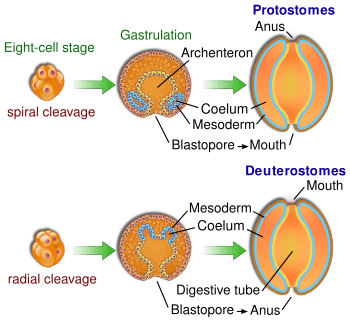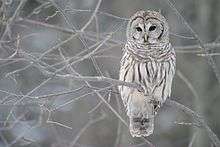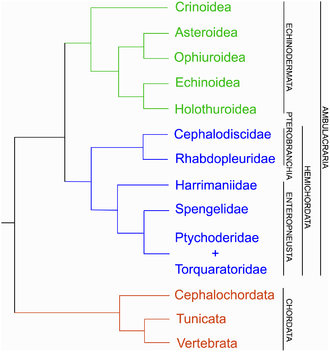Deuterostome
| Deuterostomes Temporal range: Cambrian - Present 521–0 Ma | |
|---|---|
 | |
| A sea cucumber | |
| Scientific classification | |
| Kingdom: | Animalia |
| Clade: | Nephrozoa |
| Superphylum: | Deuterostomia Grobben, 1908 |
| Phyla | |
Deuterostomes (taxonomic term: Deuterostomia; from the Greek: "mouth second") are any members of a superphylum of animals. It is a sister clade of Protostomia, with which it forms the Nephrozoa clade.
Deuterostomia is a subtaxon of the Bilateria branch of the subkingdom Eumetazoa, within Animalia, and are distinguished from protostomes by their embryonic development; in deuterostomes, the first opening (the blastopore) becomes the anus, while in protostomes, it becomes the mouth.
Deuterostomes are also known as enterocoelomates because their coelom develops through enterocoely.
There are four extant phyla of deuterostomes:
- Phylum Chordata (vertebrates and their kin)
- Phylum Echinodermata (starfish, sea urchins, sea cucumbers, etc.)
- Phylum Hemichordata (acorn worms and graptolites)
- Phylum Xenacoelomorpha[1]
Classification history
Previously, Deuterostomia also included the phyla Brachiopoda, Bryozoa, Chaetognatha, and Phoronida based on embryological characteristics.
However, Superphylum Deuterostomia was redefined in 1995 based on DNA molecular sequence analyses when the lophophorates were removed from it and combined with other protostome animals to form superphylum Lophotrochozoa.[2] The phylum Chaetognatha (arrow worms) may belong here, but molecular studies have placed them in the protostomes more often.
Extinct deuterostome groups may include the phylum Vetulicolia, other extinct lineages may be found in future.
Echinodermata, Hemichordata and Xenoturbellida form the clade Ambulacraria.[3] The present phylum Priapulida also has a deuterostomic development, despite being otherwise placed within the protostomes.[4]

Notable characteristics
In both deuterostomes and protostomes, a zygote first develops into a hollow ball of cells, called a blastula. In deuterostomes, the early divisions occur parallel or perpendicular to the polar axis. This is called radial cleavage, and also occurs in certain protostomes, such as the lophophorates.
Most deuterostomes display indeterminate cleavage, in which the developmental fate of the cells in the developing embryo are not determined by the identity of the parent cell. Thus, if the first four cells are separated, each cell is capable of forming a complete small larva; and if a cell is removed from the blastula, the other cells will compensate.
In deuterostomes the mesoderm forms as evaginations of the developed gut that pinch off, forming the coelom. This is called enterocoely.
Both the Hemichordata and Chordata have gill slits, and primitive fossil echinoderms also show signs of gill slits. A hollow nerve cord is found in all chordates, including tunicates (in the larval stage). Some hemichordates also have a tubular nerve cord. In the early embryonic stage, it looks like the hollow nerve cord of chordates.
Because of the degenerated nervous system of echinoderms, it is not possible to discern much about their ancestors in this matter, but based on different facts it is quite possible that all the present deuterostomes evolved from a common ancestor that had pharyngeal gill slits, a hollow nerve cord, circular and longitudinal muscles and a segmented body.[5] It could have resembled the small group of Cambrian urochordate deuterostomes named Vetulicolia.
Formation of mouth and anus

The defining characteristic of the deuterostome is the fact that the blastopore (the opening at the bottom of the forming gastrula) becomes the anus, whereas in protostomes the blastopore becomes the mouth. The deuterostome mouth develops at the opposite end of the embryo from the blastopore and a digestive tract develops in the middle, connecting the two.
Origins and evolution
The majority of animals more complex than jellyfish and other Cnidarians are split into two groups, the protostomes and deuterostomes. Chordates (which include all the vertebrates) are deuterostomes.[6] It seems very likely that the 555 million year old Kimberella was a member of the protostomes.[7][8]

The existing geological evidence suggests that the protostome and deuterostome lineages must have split some time before Kimberella appeared — at least 558 million years ago, and hence well before the start of the Cambrian 541 million years ago.[6]In essence the Chordate lineage split from another lineage during the later part of the Ediacaran Era (circa 635-542 Mya, around the end of global Marinoan glaciation in the late Neoproterozoic).
Fossils of one major deuterostome group, the echinoderms (whose modern members include sea stars, sea urchins and crinoids), are quite common from the start of Series 2 of the Cambrian, 521 million years ago.[10] The Mid Cambrian fossil Rhabdotubus johanssoni has been interpreted as a pterobranch hemichordate.[11] Opinions differ about whether the Chengjiang fauna fossil Yunnanozoon, from the earlier Cambrian, was a hemichordate or chordate.[12][13] Another Chengjiang fossil, Haikouella lanceolata, also from the Chengjiang fauna, is interpreted as a chordate and possibly a craniate, as it shows signs of a heart, arteries, gill filaments, a tail, a neural chord with a brain at the front end, and possibly eyes — although it also had short tentacles round its mouth.[13] Haikouichthys and Myllokunmingia, also from the Chengjiang fauna, are regarded as fish.[14][15] Pikaia, discovered much earlier but from the Mid Cambrian Burgess Shale, is also regarded as a primitive chordate.[16]
On the other hand, fossils of early chordates are very rare, as non-vertebrate chordates have no bone tissue or teeth, and fossils of no Post-Cambrian non-vertebrate chordates are known aside from the Permian-aged Paleobranchiostoma, trace fossils of the Ordovician colonial tunicate Catellocaula, and various Jurassic-aged and Tertiary-aged spicules tentatively attributed to ascidians.
Classification
Here are the following phyla\subgroups of the deuterostomes.
- Superphylum Deuterostomia
- Phylum Chordata (vertebrates, tunicates, and lancelets)
- Subphylum Cephalochordata - 1 class (lancelets)
- Subphylum Tunicata (Urochordata) - 4 classes (tunicates)
- Subphylum Vertebrata (Craniata) - 9 classes (vertebrates - mammals, reptiles, amphibians, birds, and fish)
- Infraphylum Agnatha (Cyclostomata or incertae sedis) - 2 classes (jawless fish - hagfish and lampreys)
- Infraphylum Gnathostomata - 7 classes (jawed vertebrates - mammals, reptiles, amphibians, birds, bony fish, and cartilaginous fish)
- Superclass incertae sedis - 1 class (cartilaginous fish - sharks, skates, rays, and chimaeras)
- Superclass Osteichthyes - 2 classes (bony fish, 98.8 percent of all fish - ray-finned fish and lobe-finned fish)
- Superclass Tetrapoda - 4 classes (four-limbed vertebrates - mammals, reptiles, amphibians, and birds)
- Phylum Hemichordata - 3 classes (hemichordates, known as acorn worms)
- Phylum Echinodermata (echinoderms - sea stars, brittle stars, sea lilies, sea urchins, and sea cucumbers)
- Subphylum Asterozoa - 2 classes (sea stars and brittle stars)
- Subphylum Crinozoa - 1 class (sea lilies)
- Subphylum Echinozoa - 2 classes (sea urchins and sea cucumbers)
- Phylum Xenacoelomorpha (tiny wormy creatures)
- Subphylum Acoelomorpha - 2 classes (tiny flattened worms)
- Subphylum Xenoturbella - 1 class (simple, marine, worm-like creatures)
- Phylum Chordata (vertebrates, tunicates, and lancelets)
References
- ↑ Perseke M.; Hankeln T.; Weich B.; Fritzsch G.; Stadler P.F.; Israelsson O.; Bernhard D.; Schlegel M. (March 2007). "The mitochondrial DNA of Xenoturbella bocki: genomic architecture and phylogenetic analysis" (PDF). Theory in Biosciences. 126 (1): 35–42. doi:10.1007/s12064-007-0007-7. PMID 18087755. Retrieved 2015-11-06.
- ↑ Halanych, K.M., Bacheller, J., Liva, S., Aguinaldo, A. A., Hillis, D.M. and Lake, J.A. (17 March 1995). "18S rDNA evidence that the Lophophorates are Protostome Animals". Science. 267 (5204): 1641–1643. Bibcode:1995Sci...267.1641H. doi:10.1126/science.7886451. PMID 7886451.
- ↑ Bourlat S. J.; Juliusdottir T.; Lowe C. J.; Freeman R.; Aronowicz J.; Kirschner M.; Lander E. S.; Thorndyke M.; Nakano H.; et al. (2 November 2006). "Deuterostome phylogeny reveals monophyletic chordates and the new phylum Xenoturbellida". Nature. 444 (7115): 85–88. Bibcode:2006Natur.444...85B. doi:10.1038/nature05241. PMID 17051155.
- ↑ Martín-Durán, J.M.; Janssen, R.; Wennberg, S.; Budd, G.E. & Hejnol, A. (20 November 2012). "Deuterostomic Development in the Protostome Priapulus caudatus". Current Biology. 22 (22): 2161–2166. doi:10.1016/j.cub.2012.09.037. Retrieved 2015-11-04.
- ↑ Smith, Andrew B. (2012). "Cambrian problematica and the diversification of deuterostomes". BMC Biology. 10 (79): 1–3. doi:10.1186/1741-7007-10-79. Retrieved 2015-11-04.
- 1 2 Erwin, Douglas H.; Eric H. Davidson (1 July 2002). "The last common bilaterian ancestor". Development. 129 (13): 3021–3032. PMID 12070079.
- ↑ New data on Kimberella, the Vendian mollusc-like organism (White sea region, Russia): palaeoecological and evolutionary implications (2007), "Fedonkin, M.A.; Simonetta, A; Ivantsov, A.Y.", in Vickers-Rich, Patricia; Komarower, Patricia, The Rise and Fall of the Ediacaran Biota, Special publications, 286, London: Geological Society, pp. 157–179, doi:10.1144/SP286.12, ISBN 9781862392335, OCLC 156823511
- ↑ Butterfield, N.J. (December 2006). "Hooking some stem-group "worms": fossil lophotrochozoans in the Burgess Shale". BioEssays. 28 (12): 1161–6. doi:10.1002/bies.20507. PMID 17120226.
- ↑ Tassia, Michael G.; Cannon, Johanna T.; Konikoff, Charlotte E.; Shenkar, Noa; Halanych, Kenneth M.; Swalla, Billie J. (2016-10-04). "The Global Diversity of Hemichordata". PLOS ONE. 11 (10): e0162564. doi:10.1371/journal.pone.0162564. ISSN 1932-6203.
- ↑ Bengtson, S. (2004). Lipps, J.H.; Waggoner, B.M., eds. "Early Skeletal Fossils in Neoproterozoic–Cambrian Biological Revolutions" (PDF). Paleontological Society Papers. 10: 67–78. Retrieved 2008-07-18.
- ↑ Bengtson, S.; Urbanek, A. (October 2007). "Rhabdotubus, a Middle Cambrian rhabdopleurid hemichordate". Lethaia. 19 (4): 293–308. doi:10.1111/j.1502-3931.1986.tb00743.x. Retrieved 2008-09-23.
- ↑ Shu, D., Zhang, X. and Chen, L. (April 1996). "Reinterpretation of Yunnanozoon as the earliest known hemichordate". Nature. 380 (6573): 428–430. Bibcode:1996Natur.380..428S. doi:10.1038/380428a0. Retrieved 2008-09-23.
- 1 2 Chen, J-Y.; Hang, D-Y. & Li, C.W. (December 1999). "An early Cambrian craniate-like chordate". Nature. 402 (6761): 518–522. Bibcode:1999Natur.402..518C. doi:10.1038/990080. Retrieved 2008-09-23.
- ↑ Shu, D-G.; Conway Morris, S.; Han, J.; et al. (January 2003). "Head and backbone of the Early Cambrian vertebrate Haikouichthys". Nature. 421 (6922): 526–529. Bibcode:2003Natur.421..526S. doi:10.1038/nature01264. PMID 12556891. Retrieved 2008-09-21.
- ↑ Shu, D-G.; Conway Morris, S. & Zhang, X-L. (November 1999). "Lower Cambrian vertebrates from south China" (PDF). Nature. 402 (6757): 42. Bibcode:1999Natur.402...42S. doi:10.1038/46965. Retrieved 2008-09-23.
- ↑ Shu, D-G.; Conway Morris, S. & Zhang, X-L. (November 1996). "A Pikaia-like chordate from the Lower Cambrian of China". Nature. 384 (6605): 157–158. Bibcode:1996Natur.384..157S. doi:10.1038/384157a0. Retrieved 2008-09-23.
External links
| Wikispecies has information related to: Deuterostomia |
| Wikimedia Commons has media related to Deuterostomia. |
- UCMP-Deuterostomes
- Deciphering deuterostome phylogeny: molecular, morphological and palaeontological perspectives
- Deuterostomia at Encyclopædia Britannica